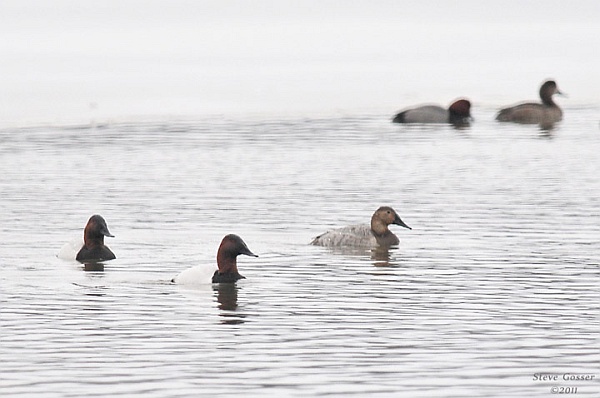
Last Friday I gave tips for identifying swimming dabblers without a scope. Today I’ll give similar descriptions for about half the species of diving ducks we see in western Pennsylvania. The other half will follow in the days to come.
All of today’s birds dive to get their food. Sometimes they swim underwater for several minutes. Because they dive, their legs are set back on their bodies so they run on the water to take off.
To save space I’ve abbreviated: “=M” is same size as mallard, “<M” smaller than mallard, “>M” bigger than mallard. “HFAM” means Hope For A Male” because the females are really hard to identify.
Don’t be fooled. I’m no ace birder with these birds. I’m often stumped by the difficult divers.
- Canvasbacks and Redheads: Look alike with rusty red head, black breasts and butts, white/gray backs. Slightly <M.
- Canvasbacks: Long sloping forehead and bill. Bill is black. Male’s back is white.
- Redheads: Round mallard-shaped head and bill. Pale bill with white ring, black tip. Male’s back is gray.
- Ring-necked duck, Greater scaup, Lesser Scaup: Males look alike with dark head, black breast and butt, white sides. Females dark brown. Female scaup have white feathers on face around bill. HFAM. All <M.
- Ring-necked duck: Bouffant-shaped head. Should be named ring-billed duck for dark bill with bright white ring. Black back, white notch at shoulder.
- Greater scaup: Round head peaks at forehead, if at all. Male’s back is palest of the three.
- Lesser scaup: Exactly like greater scaup except head has definite peak at top and back.
- Mergansers: Long, low in water, long thin bill, “no neck” look. Almost all have crests like blown-back hair. Females quite similar. You can hope for a male, but the first 2 species tend to hang out in same-sex groups. In fall, immature males resemble females.
- Common merganser: =M. Male is white with dark head (no crest) and bright orange bill. Female has rusty crested head, white breast, definite border between rust and white.
- Red-breasted merganser: <M. Has crest like wild blown-back hair. Male has dark head, streaked rust breast. Female is exactly like female c.merg except front of neck is whitish, no border between rust and white. Slightly smaller than c.merg. HFAM.
- Hooded merganser: much <M. Male unmistakable with black head and white patch on crest which he raises to show off. Female is all-dark brown with merganser-female profile but much smaller. HFAM.
- Not ducks, but these two divers look similar from a distance:
- Common loon: >M. Study winter and summer plumage beforehand. Rides low in water with neck “scrunched.” Long pointed bill. Swims with bill straight out, parallel to water.
- Double-crested cormorant: >M. More common in western Pennsylvania than loons. All dark. Long pointy bill with down-hook at tip. Swims with neck up and bill slightly raised.
Now that you know what to look for, who’s in this photo?
(photo by Steve Gosser)
*pssssst* if you hover over the pic it gives the answer ….. so I cheated so I won’t give an answer 😉
If you read this blog before 9:17am on Nov 4 you may have noticed a typo in which I mistyped Red-breasted Mergansers and said ‘headed’ instead of ‘breasted.’ Aaaarrrrggg! Fortunately Bill Parker caught it.
lol, sharon, you temptress. I used your tip to verify my answer. Rather disingenuous of the Redheads to be out of focus.
Kate — one of my bird books suggests that Male Greater Scaup have white flanks while Lesser have grayish. Do you know if this tip is any help in the field? (I’m pretty sure all the Scaup I’ve seen were lesser.)
I think gray versus white is a good tip for the scaup. The light is often so poor here in western PA (overcast!) that there are times when it’s hard to tell gray from white unless both species are present.